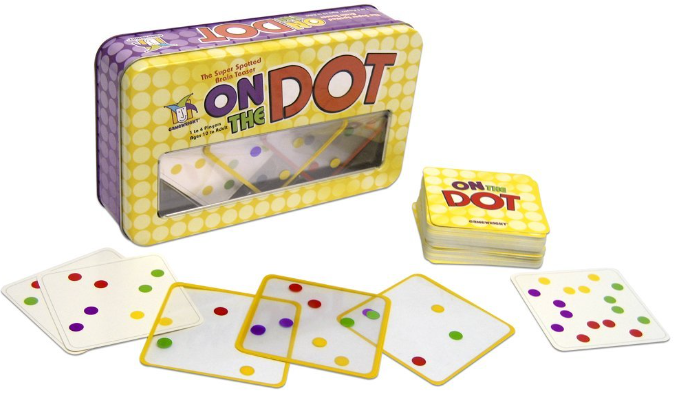 |
| On the Dot - Flip and rotate 4 cards to match the challenge card. |
On the Dot includes 16 transparent cards (four identical sets of four cards) so that up to four players can play. Each set of four has a different color border so you can easily separate the sets. This is a game you could easily play alone.
The 64 pattern cards increase in difficulty, but they are not numbered or identified in any order. Some have as few as four dots, some have as many as sixteen. Some patterns are symmetrical, some patterns are just random dots. All four transparent cards must be stacked on top of each other so that they form the pattern on the pattern card.
Object:
Be the first to arrange your cards to match the pattern card. First player to win five patterns cards wins the game.
Set up:
Give each player a set of four transparent cards. Place the stack of pattern cards face-down on the table. Turn over the top pattern card.
Play:
All players race to see who can be the first to stack their transparent cards into the same pattern as on the pattern card. The first player to do so yells "On the Dot" and all play stops until the solution is checked against the pattern card. If the player is correct, he takes the pattern card and a new pattern card is revealed. If he is incorrect, he is out of the round while the rest of the players continue until a winner is announced. Play until someone wins five cards and wins the game. It comes in a new paper box now.
If you would like to read more about one-person logic puzzles, check out my post What's in Your Therapy Box? Logic Puzzles Edition.
Try this:
- Practice turning the cards to cover the dots by holding the pattern card in your hand and covering dots with one transparent card at a time. Don't worry about matching color, just work on how to turn and flip the cards to cover the dots.
- Start by playing alone and placing the pattern card at the bottom of your transparent stack while playing.
- Use consistent language to cue the person, such as flip, rotate, turn to left, turn right, etc.
- Try one card, turning it to each of the four directions, until you find a possibility before picking up the next card.
- Play alone, forget the time pressure and work until you solve the puzzle.
- Solve three puzzles before you meet with the individual to reduce down-time as someone tries to complete the puzzle, as no answer key is included. Give the individual the fourth set of transparent cards and then check his answers against your finished sets. This way you can also start the individual off with a correct card or two if he needs help getting started.
- Solve three puzzles before you meet with the individual. Use the fourth transparent set for the individual. Puzzle 1 - Copy three of your cards onto his set and then ask the individual to place the fourth card. Puzzle 2 - Copy two of your cards onto his set and ask them to place the remaining two cards to solve the puzzle. Puzzle 3 - Start the individual off by copying one of your cards and ask them to solve the other three cards.
- Work
on manual dexterity, in-hand manipulation, coordinated use of both
hands, visual discrimination, visual closure, visualization, eye-hand coordination,
spatial relations, figure ground, working memory, socialization skills,
executive functioning skills, process skills, play and leisure exploration and
participation
In the box: 64 pattern cards, 16 transparent cards
Ages 10+. 1-4 players
.



No comments:
Post a Comment
Thank you for taking the time to comment.